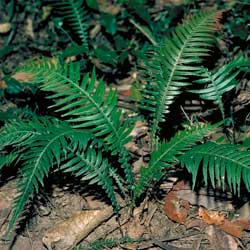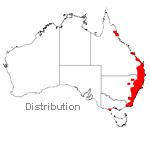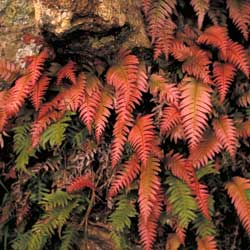Doodia aspera
 |
Prickly Rasp fern
Doodia aspera, commonly known as the Prickly Rasp Fern, was the first Australian fern brought to Kew Garden, UK. It belongs to the Blechnaceae family, a cosmopolitan family which consists of 8 genera worldwide.
 This fern is found growing in a variety of habitats such as rainforest margins, eucalypt forests and rainforests. It is well adapted to both sunny and shaded areas. The fern occurs in Queensland, eastern New South Wales, and eastern Victoria.
This fern is found growing in a variety of habitats such as rainforest margins, eucalypt forests and rainforests. It is well adapted to both sunny and shaded areas. The fern occurs in Queensland, eastern New South Wales, and eastern Victoria.
D. aspera is a terrestrial fern producing short-creeping rhizomes and erect fronds. The fern can reach height to 35 cm. Its rhizome is small and covered with black scales. The fertile and sterile fronds are similar in appearance. The fronds are 0.15 – 0.4 m tall and are ovate to lanceolate in shape. The new growth fronds are bright pink but old ones are green. This feature makes the fern an attractive plant for garden culture. The fern produces sori in one or two rows. Each sorus is covered by an oblong indusium which opens towards the midrib. The indusium is 1 mm long, and generally has a kidney shape. Sori are 0.8 – 2 mm long and 0.8 – 1.5 mm wide.
The fern is usually easy to grow in gardens, containers and baskets. Having a spreading growth habit makes D. aspera suitable as a groundcover. It grows best in shady conditions and in acidic soil, with high organic composition. Although the plants like a good level of moisture, the plants need well-drained conditions to prevent sweating problems. The sweating problem occurs when D. aspera is exposed to high water levels for long periods.
D. aspera is easy to propagate. There are two ways to propagate the fern: division of offsets and spore germination. The former is considered the simplest way to propagate the plants.
Spore germination requires three steps: collecting spores, sowing and potting on. Spores can be collected from mature fronds. To collect the spores, a frond should be placed between two pieces of paper. Next place the frond in a dry and warm area for one to two weeks. Subsequently, remove the frond from the pieces of paper, and fold the paper to store the spores.
Sow the spores on a sterilized growth medium such as chopped tree fern fiber or peat moss. Sterilization of growth medium can be done by pouring boiling water over the growth medium. After spreading the spores sparingly on the medium, place the containers in 20 oC in indirect light for two to six weeks.
Finally, transfer the well-developed prothalli (germinated spores) into a growth medium which contains soil mixture. The immature ferns should be kept in shady area and covered with plastic. When the fronds appear, the fern should be potted up into a medium containing organic matter. For more detail on fern propagation, please visit http://www.anbg.gov.au/ferns/fern.spore.prop.html.
Text by Irwan Lovadi (2006 Student Botanical Intern)
Derivation of the name: Doodia asperaDoodia - after Samuel Doody (1656-1706), apothecary and curator of the Chelsea Physic Garden, London, UK. aspera - derived from Latin “asper” meaning rough, referring to the rough stipe and rachis. |
References:
Chaffey, C. (1999) Australian ferns: growing them successfully. Kangaroo Press, New South Wales.
Harvey , R. (2002) Growing ferns from spores. Available at: http://www.anbg.gov.au/ferns/fern.spore.prop.html [Accessed January 16 2006].
Jones, D.L. (1998) Encyclopedia of ferns. Thomas C. Lothian Pty Ltd, Melbourne.
Jones, D.L. (1976) Australian ferns and fern allies. A.H. & A.W. Reed Pty Ltd, Sydney.
Parris, B.S. (1972) The Genus Doodia R.Br (Blechnaceae: Filicales) in New Zealand. New Zealand Journal of Botany,10, 585-604.
Parris, B.S. (1998) Doodia, Flora of Australia 48: 385-388
Vorobik, L.A. (2004) Growing natives: resources for growing ferns. Fremontia 32, 29.
![An Australian Government Initiative [logo]](/images/austgovt_brown_90px.gif)


